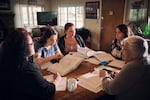
Esther Stutzman and her granddaughter Aiyanna Brown, who are Kalapuyan descendants, have spearheaded the effort to print and distribute the Kalapuya-English dictionaries published last winter.
Leah Nash / Underscore News
The tribes of the indigenous Kalapuya people have lived throughout Oregon’s Willamette Valley for thousands of years, with their own customs and languages. It’s estimated that there are 4,000 people who identify as descendants of the Kalapuya people living in Oregon today. But for the last half century, there have been no native speakers of the Kalapuyan language.
Now there’s an effort underway to preserve the Kalapuyan language. There’s a new dictionary, and some descendants of the Kalapuya people are now working to learn their ancestors’ language.
OPB Weekend Edition host John Notarianni talked with two people who are involved in the effort: Esther Stutzman and her granddaughter, Aiyanna Brown. They’re both enrolled members of the Confederated Tribes of Siletz Indians.
John Notarianni: Tell me a little bit about the Kalapuya people: At their peak, how many were there in the Willamette Valley?
Esther Stutzman: The estimate is that there were 15,000-plus living throughout the entire Willamette Valley. There were at least 12, maybe 13 different groups of Kalapuya people living in various places.

From left to right, Melissa Tuttle, Aiyanna Brown, Shannin Stutzman, Heather Moore and Esther Stutzman convene a Kalapuya language study on Jan. 31 in Yoncalla, Oregon.
Leah Nash / Underscore News
Notarianni: And your family is a part of that history, correct?
Stutzman: Yes, we are the southernmost. We actually live in the upper Umpqua region, in northern Douglas County.
Notarianni: Do you have an idea when people stopped speaking the traditional language?
Stutzman: The last known speaker, I believe, passed away in the 1950s. He did a recording, one of the few recordings of the Kalapuya language — in 1953, I believe it was.
Notarianni: Do you have any memories of the language or people talking about the language from when you were young?
Stutzman: I had an uncle who did not necessarily speak the language, but he knew a lot of the words and the phrases. He would speak those words and phrases every now and then. Of course, being a youngster, I just kind of ignored them. Now, some of that memory is coming back when I see a word or a phrase in the dictionary or I hear it, I’ll say, “Oh, I remember Uncle Joe saying that.”
Notarianni: A lot of this new effort was started in concert with an amateur linguist, the late Paul Stephen McCartney Sr., and I understand you worked with him to create a new set of dictionaries of the language. How much work did this take?
Stutzman: We first met Paul about six or seven years ago. I had kind of loudly said, on many occasions, how we would love to learn our language. Paul contacted us and asked us if we wanted our language back. Of course, we said yes. That ensued in many meetings with him, a lot of emails, a lot of phone calls because he believed that the Kalapuya language was worth saving.

Kalapuya dictionaries are stacked on a table at Esther Stutzman's home in Yoncalla, Oregon.
Leah Nash / Underscore News
Notarianni: What was it like when you held those books in your hands for the first time?
Stutzman: For me, it was magical. It was like holding history, like holding culture, with kind of all the hopes of recreating the language of the people.
Notarianni: Aiyanna, since the books have been published, you and your family have been working to relearn some of this language. How does that process work? What’s a lesson like?
Aiyanna Brown: It’s a little bit difficult because, you know, we don’t have any native speakers or any masters of the language that we can really refer back to. A lot of it, we have to bounce off of each other — whether for a pronunciation, sentence structure, or just the understanding of the word. It can be difficult at times. So, it’s been a challenge, but slowly and surely, even if it’s just one word at a time, we’re definitely trying.

Kalapuya language notes are scattered around Esther Stutzman's home, which has served as a meeting spot for language studies and distribution headquarters for the dictionaries.
Leah Nash / Underscore News
Notarianni: As you’re learning the language, are you finding that you’re thinking more about it in your daily life? Do you ever look at an object and the Kalapuya word comes into your head?
Brown: Yeah, actually quite often! I’ll go throughout my day and I’m like, “Oh, well that’s garbage, that’s gitkofin; I know that one in Kalapuya.”
Notarianni: What are some of the other words or phrases that you’ve learned?
Brown: For me personally, one of my favorite ones is our traditional introduction. It’s basically just saying my name, my heritage, who I’m related to and my native tribes. So, it’s, “Qá’pai. Tci tanq’uat Aiyanna. Tsum aná du Shannin Stutzman. Tanketsi’ Esther Stutzman. Tsum Komemma Kalapuya nau Hanis Coos.”
Notarianni: Esther, what is it like hearing your granddaughter speaking Kalapuya?
Stutzman: Oh, it makes me really proud and hopeful. I know that the younger generation is going to carry it on. We’re doing that through offering some classes, not only for our people, but for other interested people who would like to learn also.
Notarianni: What are your hopes for the future of the Kalapuyan language and the Kalapuya people?
Stutzman: My real hope is that maybe Aiyanna’s generation will be fairly fluent in the language. I think it’s going to take that long. I know that in my lifetime I will never speak it fluently. just because there’s so much to learn, but the younger generation has that time to learn it. So, what we’re doing is we’re building a foundation right now. That, to me, is the important step one: It’s that foundation.
Listen to Esther Stutzman and Aiyana Brown’s conversation with OPB Weekend Edition host John Notarianni: